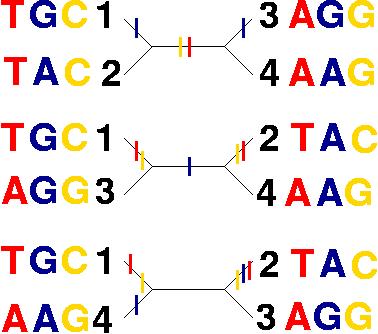| position | |||
| 1 | 2 | 3 | |
| Sequence1 | T | G | C |
| Sequence2 | T | A | C |
| Sequence3 | A | G | G |
| Sequence4 | A | A | G |

Then consider each position separately:
- Position 1: Only one change is introduced if sequences 1 and 2 are grouped, while two changes will be necessary if sequences 1 and 3 or 1 and 4 are grouped.
- Position 2: Only one change is introduced if sequences 1 and 3 are grouped, while two changes will be necessary if sequences 1 and 2 or 1 and 4 are grouped.
- Position 3: Only one change is introduced if sequences 1 and 2 are grouped, while two changes will be necessary if sequences 1 and 3 or 1 and 4 are grouped.
- If 1 and 2 are grouped a total of four changes are needed.
- If 1 and 3 are grouped a total of five changes are needed.
- If 1 and 4 are grouped a total of six changes are needed.
Hence, the shortest tree is ((1,2)(3,4)).